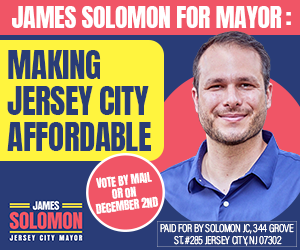Jersey City Mayor Steven Fulop pitched his new plan for the Centre Pompidou to the city council this afternoon, his first remarks on the project after penning an editorial for HCV on Friday, with Councilmen Rich Boggiano and Frank “Educational” Gilmore skeptical.
By Daniel Ulloa/Hudson County View
“We had an individual presentation with a lot of you and being the significance of what we’re asking for support, I wanted to come here and walk through it publicly, talk about the finances, and answer any questions, clearly, on the record,” Fulop told the governing body.
“I want to take you back to over 10 years ago because I think that’s an important data point for us about tax abatements and how the city approached them. 10-plus years ago, tax abatements were generally regarded as by right.”
The mayor, also a Democratic candidate for governor, noted that while tax abatements have not been used much in recent years, they have sometimes been very beneficial to the city, citing Public School No. 16 and the new East District Police District as examples.
” … That would not be possible without us using and leveraging the city’s finances through creative structures,” he also said, adding that “today we’re talking about a project that many of you have been courageous enough to support for five years now.”
Without saying it explicitly, Fulop acknowledged that the situation took a turn for the worse when the New Jersey Economic Development Authority pulled their support from the project in June, which Fulop has previously said occurred because he pulled his endorsement of First Lady Tammy Murphy in favor of U.S. Rep. Andy Kim (D-3).
Despite that, he said the administration was “unwilling to walk away” from a project of this magnitude and started brainstorming alternatives before they ended up on this one, which includes a 30-year abatement for the KRE Group at 808 Pavonia Ave. that the council will vote on first reading at Wednesday’s meeting.
Fulop then did a short presentation with renderings before opening it up to questions with the council.
“ … The streets are horrible. Journal Square’s a mess! … People are concerned about what’s going on,” Ward C Councilman Boggiano exclaimed.
“I’m not against it. What are the French contributing? How much is this going to cost us taxpayers? Who’s going to pay for it? These are the questions they want to know. If Pompidou doesn’t come in, who’s going to staff this place? We don’t have enough personnel to take care of the city right now.”
Fulop acknowledged that “construction is a nuisance and burdensome,” but state and municipal laws need to be followed and people will appreciate the finished products.
“The city will make 11 million or more, per year, because of this cultural institution being there. So from a dollars and cents standpoint, we will benefit from that,” the mayor added, claiming that it’s really more of a cultural institution than just an art museum.
He was also clear that even if the abatement was voted down, the project would still move forward without it.
“Steve, I never said I was against this, but what’s this gonna cost the taxpayers? … The stores in Journal Square aren’t open. Book stores are closed, the restaurants are gone … and I’m the one whose taking a beating for this because I’m the councilperson for Ward C,” Boggiano replied.
Fulop answered that it is the same exact model that is being used in Abu Dhabi, Brussels, and Shanghai, later stating that “a critical mass of development” is needed before restaurants and night life thrives.
“Do we know the actual dollar amount the city will be missing out on versus if they paid regular taxes vs. taxes in the PILOT and what is that number?” Gilmore asked.
Michael Hanley, a principal for NW Financial Group, said the PILOT has a value of about $55 million to $65 million before Gilmore interjected again.
“The question is the amount of revenue the city will receive if it’s a regular tax versus the PILOT?” Gilmore asked, with Hanley essentially repeating himself.
“We’re going to receive approximately slightly more than half than what conventional taxes would,” he later added, prompting Gilmore to press again on the exact number.
Fulop chimed in that “nobody would know that” since the building doesn’t exist yet.
“Say, in the first year that each building is stabilized, we’ll receive approximately $4 million, whereas we would receive 7.7 million dollars – something in that range,” Hanley said..
Gilmore said he’d rather have an affordable housing component included with the abatement, rather than receiving nearly $2 million to the affordable housing trust fund.
“ … You have a building that’s going to be built and they are going to make a payment based on that ordinance. So nothing has changed that would have happened without this project, what is happening with this project,” Hanley explained.
“What we’ve done is make a financial trade as it relates to future cash flow and the asset we’re going to receive and it’s a good, fair trade. Building affordable housing units inside it would change the economics of the whole project and we don’t have the ability to make the developer to that, and in order to do so, it would have a tremendous cost.”
Gilmore was adamant that he’d like to see units for people in the city that earn less than figures a year before Fulop jumped in.
“The choice is not really affordable or no affordable. The building is getting constructed based on the zoning that existed, that we all agreed upon, or the prior administration agreed upon, without affordable housing, and they didn’t put in place labor union requirements,” Fulop declared.
Gilmore remained dissatisfied with their current predicament.
“ … You’re asking taxpayers to front the bill for this … There has been no open dialogue as it relates to communication with the community at large, letting the taxpayers who are fronting this have the ability to agree, disagree,” he stated.
“I feel like it’s being forced down our throat, we just had a meeting about this two weeks ago, it’s right before the council, there have been no community meetings.”
Fulop emphasized that it is a fair trade for everyone involved, as well as that the community has engaged in this process for five years.
“Which community?” Gilmore asked.
“Everybody, this is not a new project,” Fulop exclaimed.
Gilmore answered that the tax abatement is certainly new and has not had any public engagement, to which Fulop said there is a first and second reading that allows the public to comment.
Later, Ward B Councilwoman Mira Prinz-Arey asked what has changed about the operating budget for the project.
Fulop said they tried to create a 10-year plan includes philanthropy, government grants, and a partnership with the library, also stating “the city’s contribution is very minimal.”
He later added that construction on Phase I, which includes 595 market rate residential units, approximately 6,038 square feet of gallery and cafe space, and approximately 237 parking spaces, within a year.
Gilmore later raised further objections.
“I think the questions should be is it worth having or not. Is it worth the bang for the buck the taxpayers are going to be charged?” he asserted.
“We’re going to get our 55 or $60 million. We are giving up that cash flow today to get an asset that doesn’t exist,” Hanley replied.
“People have been bent out over shape over the cost and the tax rate,” Gilmore said.
“If the asset is valuable, you’re getting it at a price you can’t get anywhere else,” Hanley argued.
Upon further questioning from Gilmore, Fulop also committed to doing a community meeting next week if that’s what the council wants.
Ward E Councilman James Solomon, who has already said he will vote no, wanted to know about the economic impact study done.
Jersey City Redevelopment Agency Executive Director Dianna Jeffrey said a consultant was hired to perform the work, who determined that construction will result in $116 million in compensation for about 1,300 jobs.
She added that the city will get $11.1 million in revenue and $229 million over 30 years, with roughly 225 jobs created.










Mayor Ful-o-sh** doesn’t get community inputs, some who have more knowledge or expertise than his administrative people.
One thing we can always count on is that Fulop’s numbers always need to be verified.
He’s so concerned about this project and giving tax exemptions what about the people who have lived here 20 30 years and are now paying 34k a year in property taxes. 34k tell me what we’re getting for that because I don’t see it. What I see is to many trees that aren’t trimmed over growth of sidewalk grass, garbage, vomit, dog shit, piss on the stairs so again I ask where is my 34k being used for in jc.
Once again the JC home owners will be left to pick up bill for this project through our taxes going up. What is the purpose of this museum when JC is dirty , streets are a mess,the schools systems are a joke ,JC workers don’t answer the phone or complaints but we need a museum from another country
Thank you for speaking up Gilmore! Affordable housing is a must!